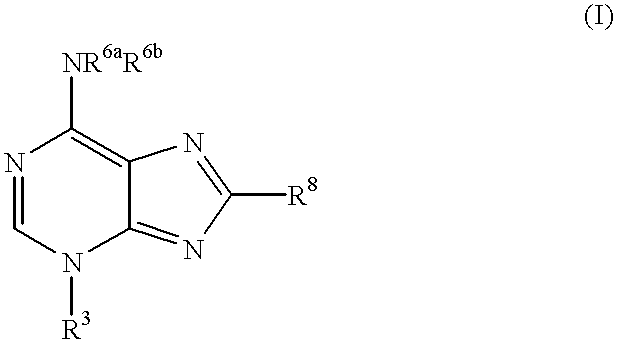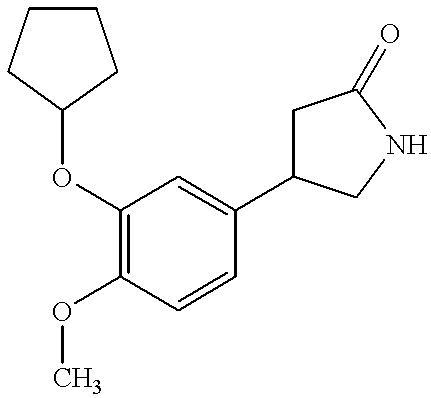Purine derivatives having phosphodiesterase iv inhibition activity
a technology of phosphodiesterase and inhibitors, applied in the field of purine derivatives having phosphodiesterase iv inhibition activity, can solve the problems of increasing cardiac contractility force and rate, increasing the number of structural classes of pde iv inhibitors, and undesirable side effects
- Summary
- Abstract
- Description
- Claims
- Application Information
AI Technical Summary
Benefits of technology
Problems solved by technology
Method used
Image
Examples
example 2
3,8-Diethyl-6-morpholino-3H-purine
(i) 3,8-Diethyl-2,6-dithioxanthine
19.14 g of 3,8-diethyl-2-thioxanthine and 22.75 g of phosphorus pentasulfide were refluxed in 280 ml of pyridine for 4.5 hrs. After cooling to room temperature 113 ml of 2N NaOH were added during 15 minutes under vigorous stirring and cooling. The suspension was filtered, washed with pyridine and concentrated in vacuo. The residue was suspended in 150 ml of water and concentrated to remove the pyridine. Suspension in water and collection of the solid gave the crude product, which is dissolved in 150 ml of 1N NaOH, treated with two portions of 0.5 g of charcoal, and filtered. The filtrate was slowly acidified with 38 ml of 5N HCl to pH 3 and a solid collected. The dried crude product (19.85 g) was suspended in 400 ml of 2-propanol at 95.degree. C. After cooling to room temperature the solid (17.62 g) is collected and washed.
(ii) 3,8-Diethyl-3,7-dihydro-6-morpholino-2H-purine-2-thione
The product of stage (i) (14.42 g)...
example 3
8-Cyclopropyl-3-ethyl-6-ethylamino-3H-purine
(i) 8-Cyclopropyl-3-ethyl-6-ethylamino-3,7-dihydro-2H-purine-2-thione
8-cyclopropyl-3-ethyl-2,6-dithioxanthine (20.19 g) prepared according to the method of example 2(i), and 70% ethylamine in water (320 ml 4.0M) were placed in a 450 ml pressure reactor and heated to 150.degree. C. for 6 hours. The reaction solution was cooled to room temperature, treated with 2 portions of charcoal (0.2 g) filtered, and evaporated to dryness. The residue was triturated in methanol (300 ml), concentrated to about 200 ml, and the solid collected (16.48 g), mp 265.degree. with decomposition.
(ii) 8-Cyclopropyl-3-ethyl-6-ethylamino-3H-purine
The product of step (i) (11.85 g) was dissolved in 2N NaOH (270 ml) and 10N NaOH (27 ml) and heated to 65.degree. C. Within 1.25 hours 50% Ni--Al alloy (518 mmoles of Ni and 1125 mmoles of Al) (60.8 g) was added under vigorous stirring at 65-70.degree. C. After a further 0.75 hr at the same temperature the reaction mixture w...
example 4
A. 8-(3-Cyclopentyloxy-4-methoxybenzyl)-3-ethyl-6-ethylamino-3H-purine Hydrochloride
B. 8-(3-Cyclopentyloxy-4-hydroxybenzyl)-3-ethyl-6-ethylamino-3H-purine
(i) 3-Cyclopentyloxy-4-methoxy-benzyl Alcohol
To a solution of 48.70 g (220 mmoles) of 3-cyclopentyloxy-4-methoxybenzaldehyde in 250 ml of methanol was added portionwise 8.57 g (220 mmoles) of 97% sodium borohydride within 10 min at 15-22.degree. C. under cooling. After a further 20 min the methanol was removed in vacuo and the residue taken up in 10 ml of water and 300 ml of ether. The ether phase was evaporated to dryness: 48.5 g (99.2%) of liquid benzyl alcohol.
(ii) 3-Cyclopentyloxy-4-methoxy-benzyl Cyanide
To a solution of 40.00 g (180 mmoles) of benzyl alcohol in 530 ml of dichloromethane was added within 5 min 32.7 ml (450 mmoles) of thionyl chloride. The solution was evaporated in vacuo to dryness, which was repeated after toluene addition: 46.30 g (106.9%) of crude benzyl chloride, which was dissolved in 230 ml of dimethylfor...
PUM
| Property | Measurement | Unit |
|---|---|---|
| pH | aaaaa | aaaaa |
| pH | aaaaa | aaaaa |
| temperature | aaaaa | aaaaa |
Abstract
Description
Claims
Application Information
 Login to View More
Login to View More - R&D
- Intellectual Property
- Life Sciences
- Materials
- Tech Scout
- Unparalleled Data Quality
- Higher Quality Content
- 60% Fewer Hallucinations
Browse by: Latest US Patents, China's latest patents, Technical Efficacy Thesaurus, Application Domain, Technology Topic, Popular Technical Reports.
© 2025 PatSnap. All rights reserved.Legal|Privacy policy|Modern Slavery Act Transparency Statement|Sitemap|About US| Contact US: help@patsnap.com



